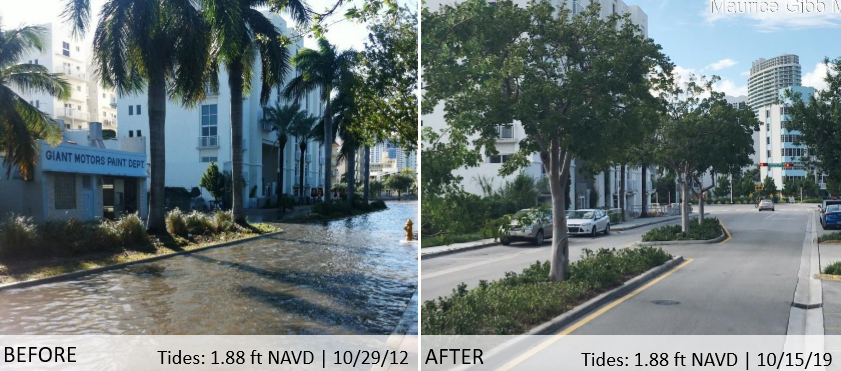To raise or not to raise the roadways
Nowhere in Florida is flooding from heavy rain events and King Tides more evident than in beautiful (and almost always sunny) Miami Beach. The city of 92,000 residents and 8.6 million annual visitors has had to get creative in recent years to develop stronger stormwater management and resilience strategies to fight back Mother Nature and this current period of slowly increasing sea levels around the Florida peninsula. But the choices seem to be getting more difficult.
It’s a strange sight for sure. It can be a perfectly sunny day, and certain streets along waterways can have water on the road due to the annual King Tide – which occurs during a full or new moon coinciding when the moon is closest to the Earth.
In addition to more traditional stormwater improvement projects, Miami Beach in recent years began implementing a city-wide plan to elevate roads to help keep them dry. A recent Miami Herald article explains the dilemma the city now faces as it continues down this path.

The effects of Miami Beach, Florida’s stormwater management program. Courtesy, City of Miami Beach
Some residents have complained about water flowing down from these 3.7 foot-higher roads onto their properties and the resulting flooding and insurance issues. One case pointed out in the article was a flooded restaurant that was deemed to be a basement by the National Flood Insurance Program because it was now several feet below the elevated roadway and thus ineligible for a claim payout. (Apparently, intensive lobbying by the city helped reverse that decision.)
But the city is worried in part about its own insurance rates, as well as its bond credit rating to fund future projects. That requires mitigation to reduce risks. One city commissioner pointed out that raising roads city-wide is a solution in search of a problem and may do more harm than good.
The city has tasked its consulting engineers at Jacobs Engineering to come up with a better plan. But the firm recently recommended raising key evacuation routes even higher than originally planned, while reducing planned elevations of some residential streets. Jacobs’ plan assumes continuous and rapidly increasing sea levels in the next 30 years and urges action sooner, rather than later. Critics point out that there will always be time to go back and build higher as needed, if those dire assumptions come true.
In the meantime, Jacobs is suggesting the city follow Florida Department of Transportation protocol. FDOT recently reinforced a water-damaged road not by raising it, but by using “a different, more expensive, type of ‘black base’ material underneath the road designed to protect it from rising salt water.”
LMA Newsletter of 2-10-20

